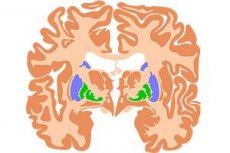Medical expert of the article
New publications
Symptoms of basal (subcortical) nuclei lesions
Last reviewed: 06.07.2025

All iLive content is medically reviewed or fact checked to ensure as much factual accuracy as possible.
We have strict sourcing guidelines and only link to reputable media sites, academic research institutions and, whenever possible, medically peer reviewed studies. Note that the numbers in parentheses ([1], [2], etc.) are clickable links to these studies.
If you feel that any of our content is inaccurate, out-of-date, or otherwise questionable, please select it and press Ctrl + Enter.

The subcortical basal ganglia are usually divided into two systems based on the features of their histological structure: striatum (neostriatum) and pallidum (paleostriatum). The first includes the caudate nucleus and putamen; the second includes the medial and lateral globus pallidus associated with the subthalamic nuclei (corpus subthalamicus Luysi), the black substance (substantia nigra), the red nuclei (nucl. ruber) and the reticular formation of the brainstem.
Numerous circular connections of the subcortical nodes of the base with the thalamus and extensive cortical fields (especially the frontal lobes) create complex extrapyramidal systems that provide automatic regulation of involuntary motor acts and participate in the regulation of voluntary movements.
When the basal nuclei are damaged, motor activity disorders occur - dyskinesia (hypokinesis or hyperkinesis ) and changes in muscle tone (hypotonia or muscle rigidity). Parkinsonism syndrome is most often encountered with this type of damage localization.
Pallido-nigro-reticular syndrome: akinesia (hypokinesia, oligokinesia), plastic hypertonia of muscles, "cogwheel" symptom, "wax doll" symptom, bradykinesia, bradylalia, propulsion, lateropulsion, retropulsion, Parkinsonian stamping on the spot, bradypsychia, paradoxical kinesia (increased postural reflexes, disturbance of posture and gait (head and torso tilted forward, arms bent at the elbows and wrists, lower limbs half-bent at the knees and slightly adducted at the hip joints), quiet monotonous voice, acheirokinesia, rhythmic tremor at rest.
Striatal lesion syndrome (hypotonic-hyperkinetic syndrome): muscle hypotonia, chorea, athetosis, choreoathetosis, facial hemispasm or paraspasm, torsion spasm, hemitremor, myoclonus. In case of subthalamic nucleus lesion - hemiballismus. In case of striatal pathology, complex hyperkinesis (for example, choreoathetosis) in combination with muscle hypotonia often occur, and in case of disorders in the pallidonigral system, muscle rigidity and hypokinesia are more characteristic; simpler types of hyperkinesis (stereotypical tremor, myoclonus) are also known.
Different types of hyperkinesis epilepsy are associated with predominantly cortical-subcortical localization of the lesion.


 [
[